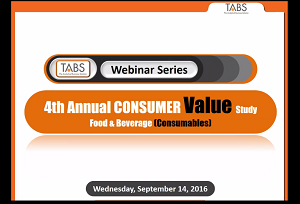Online Grocery is Failing, Except for Amazon: TABS Analytics 9/16/2016
Online grocery shopping sales continue to be weak, with just 4.5 percent of consumers regularly purchasing food and beverages online compared to 78 percent of consumers regularly purchasing food and beverages from brick and mortar grocery outlets, according to research from Sheldon, Ct.-based TABS Analytics.
According to the TABS Analytics Fourth Annual Food and Beverage Study, although regular online grocery purchasing increased by half a percentage point since the 2015 study (from 3.9 percent in 2015 to 4.5 percent in 2016), it has yet to break five percent in the four years TABS has conducted this study.
Amazon was the one bright spot in online grocery shopping, with the ecommerce giant realizing a two percent increase in shopper penetration from 14 percent in 2015 to 16 percent in 2016, the TABS study found. Amazon was the only online shopping domain to increase shopper penetration in 2016. Walmart.com remained flat in penetration at 12 percent in both 2015 and 2016, while the grocery banners, overall, dropped from 16 percent in 2015 to just 11 percent in 2016. Target.com saw a two percent grocery penetration decline from seven percent in 2015 to five percent in 2016. The decline in Target.com penetration mirrors their exit from the curbside pickup service.
“This study underscores that online grocery is failing,” said Kurt Jetta, CEO and founder of TABS Analytics. “For the fourth year in a row, consumers have turned their backs on buying groceries online no matter how much online grocery retailers try to entice them. Sixty-nine percent of consumers never buy groceries online. With only 15 percent of consumers stating loyalty to shopping for groceries online, this is not a sustainable business model, especially when you consider the industry loyalty rate benchmark is 70 percent. Food companies and grocers need to figure out why there is such a high level of dissatisfaction with the online channel before they continue to invest any further in it.”
TABS Analytics Fourth Annual Food and Beverage Study, conducted in August 2016, was developed to uncover detailed information about the U.S. CPG consumables categories and how consumer buying patterns of these categories are shaped by the promotions offered. The survey panel consisted of 1,000 geographically and demographically dispersed consumers between the ages of 18 to 75. The 15 consumables categories analyzed were carbonated beverages, salty snacks, cereal, yogurt, water, ice cream, cookies, fruit juice, refrigerated juices, crackers, frozen pizza, frozen novelties, candy, popcorn, and isotonics (sports drinks).
Brick and Mortar Grocery Remains Favorite Channel
For the fourth year in a row, the grocery brick and mortar channel continued to dominate all other shopping channels with 78 percent of U.S. consumers regularly preferring to shop in brick and mortar grocery stores. The grocery shopping channel remained stable compared to 2015, Target had a four percent decrease in regular shopping trips from 29 percent in 2015 to 25 percent. Costco, Rite Aid, and BJS all registered a two percent decrease in regular shopping trips compared to 2016.
Grocery continues to lead food and beverage purchases, with a 26 percent share for consumers regularly purchasing at a specific outlet (defined as 6 or more times per year). Grocery share was nine points higher than its nearest rival, Walmart. Only Target, Dollar, Costco, and Walgreens broke the five percent share mark. Online’s share of regular purchases was up slightly but was just 1.6 percent. The online share gain was driven by an increase in the expansion of curbside pickup services (called click and collect) across the country. Even with a significant investment in that ecommerce platform, though, only 1.0 percent of Americans say they use the format regularly for grocery shopping.
Concentrate on Households with Children, Not Millennials
Unlike the cosmetics industry that thrives on millennials buyers, just over a quarter of millennials are heavy buyers of food and beverage consumables, compared to 35 percent of households with children who are heavy buyers of food and beverages. Just 20 percent of households with no children are heavy buyers.
Millennials are also harder to target with deals than other demographic groups since their participation in deals is well below the national average, particularly circulars and free standing inserts. Despite an uptick in participation in 2016, millennials use of circulars remains a full 12 percentage points below the study average of 42 percent. The gap for free standing inserts is even larger at 14 percentage points below the study average of 34 percent.
Weak Promotions Equal Weak Sales
The 2016 TABS Food and Beverage Study corroborated industry trends of declining transactions in consumables. The vast majority of the directional changes in category trends are due to the decrease of heavy buyers. “TABS Analytics Fourth Annual Food and Beverage Study backs up that CPG manufacturers and retailers need to make a significant investment in promotional activity to sustain and grow their businesses. Weaker promotions is directly correlated to weaker sales trends,” said Jetta. “Sustained promotional levels of 15 percent to 20 percent of sales are needed to kick-start declining sales trends and bring heavy buyers back.”

